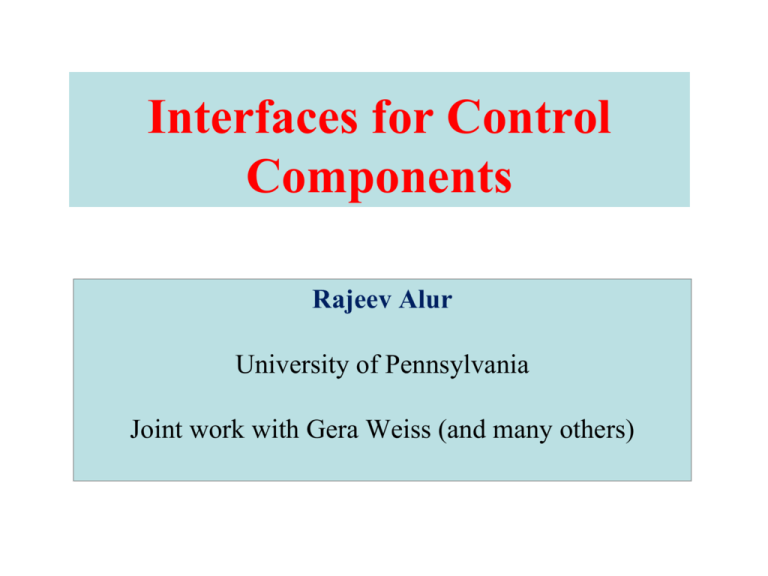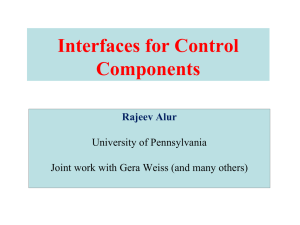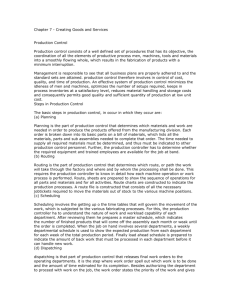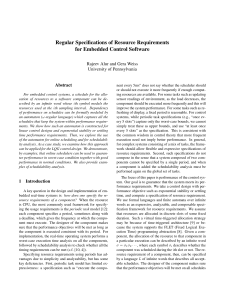Interfaces for Control Components
advertisement

Interfaces for Control
Components
Rajeev Alur
University of Pennsylvania
Joint work with Gera Weiss (and many others)
Interface-based Control Design
Control Designs
Interface: Simplified description useful for system integration
Implementation
Platforms
Interface Specs: Desirable Properties
Compositional:
Design each component in isolation
Dependable:
If interface spec is satisfied, performance goals are met
Separation of concerns:
Between control and software engineers
Analyzability:
Tool support to check if all interface specs can be met
Execution Period as Interface Spec
Control Designer:
Does sampling frequency
ensure performance spec?
5 ms
Discrete-time control theory
3 ms
Interface: Period at which sense-compute-actuate cycle to be executed
System Integrator:
Can resource requirements of all the
components be met?
Platform-specific WCET analysis
Real-time scheduling theory
Execution Period as an Interface Spec
Challenges:
Composition, adaptation to changes in resource availability, online
admission control, performance optimization
• Composing two periodic specs does not give periodic spec
• Should component be executed more frequently, if possible?
• How does period relate to control performance?
Time-triggered Resource Scheduling
Plant 1
Controller 2
Controller 1
Resource
Controller 1
Controller 2
Time
Plant 2
Automata Based Interfaces
Generalization of the periodic interface:
Automaton (regular language) for each component
specifying allowed patterns of resource allocations
1
0
1
1
1
0
Spec: Component must get at least one slot in a
window of 4 slots
0
0: Slot not allocated to the component
1: Slot allocated to the component
Automata Based Interfaces
Infinite schedules specified using Buchi automata
1
0
0
Spec: Component must get infinitely many slots
1
Example specs:
Component must get at least 2 slots in a window of 5
Eventually component must get every alternate slot
Periodic: (k 0’s . 1) *
Composing Specs
Composition : Rename followed by intersection (product)
1
1
1
0
0
0
1
1
Component A
0
1
1
1
1
0
Component B
1
Rename
A
Rename
0
A
B
0/B
A
0/A
0/A
B
A
Product
A
B
A
0
B
Schedulability Test: Check if composition of all specs is nonempty
Analyzing stability with resource scheduling
Different dynamics based on controller
has the resource or not
t models elapsed
time
Transitions happen at the
beginning of Δ intervals
Next discrete mode is determined
by the schedule σ
Challenge: Compute set of schedules s for which system is stable
Stable modes ⇏ Stability
stable
stable
unstable
Switching may introduce instability !
Can we express stability
with a Finite Automaton?
Answer: No! (Language of stable schedules is not regular)
Proof: Transform a stable word to an unstable one by pumping
Exponential Stability
Regular
Exp. Stability
Stability
Quantified version of stability
Automata-based Interfaces
Control Designer:
Specify all acceptable allocation sequences as a
regular language
E.g. Periodicity, Exponential stability, Fairness
Interface: Regular language for desired allocation on time-triggered platform
System Integrator:
Can resource requirements of all the components
be met?
Find a schedule acceptable to all using automata
constructions
Talk Overview
➡ Motivation
➡ Embedded Control Software
➡ Networked Control Systems
➡ Wireless Control Networks
Embedded Control Software
Java ???
Discrete Control
(Software)
Sensors
Actuators
Physical Plant
(Continuous Dynamics)
Java for Real-Time
Java
Bytecode portability
Component based
Java RTS
Real-time guarantees
No timing portability!
Can I run the same code on a faster machine and expect
better performance?
RTComposer
A tool for building modular Real-Time Java applications
RTComposer
Interrupts
Non Real-Time
Real-Time Java
Real-Time Operating System
Component:
Java Class + Automaton specifying patterns of method calls
Logical Execution Time
•
•
Macro Schedule: Assignment of methods to time slots
Micro Schedule: CPU scheduling within each slot
I/O
I/O
I/O
I/O
I/O
Macro
…
…
…
Micro
…
…
…
Short method
Component 1
Heavy method
Component 2
Interrupts
Tasks finish in allotted slots ⇒ Dynamics determined by macro schedule
We use automata interfaces for specifying macro schedules
Example component
Class signature: public class Example {
void p() {...};
void q() {...};
void r() {...};
}
Requirement:
Temporal logic:
Automaton:
Methods p and q not invoked for 3 consecutive slots
⇒ q must run in the next slot
Proposed Methodology
Component
Automaton
empty?
Component
Automaton
Product
Automaton
Which methods can be
executed together within
a slot?
Platform
Automaton
Macro Scheduler
inter-slot schedule
Interrupts
Background tasks
Micro Scheduler
intra-slot schedule
CPU
Timing Portability
Bytecode portability is not enough for real-time systems
Previous approaches:
Same timing on fast and slow machines [Giotto, Metronome, Exotasks]
Displacement (millimeters)
RTComposer:
Faster machines allow better performance (faster convergence)
Time (milliseconds)
Dynamic Scheduling
Static schedules [Giotto, Exotasks]:
Same set of methods in all execution slots.
Displacement (millimeters)
RTComposer:
Dynamic assignment of methods to execution slots allows to adjust to changing
conditions
Time (milliseconds)
Talk Overview
➡ Motivation
➡ Embedded Control Software
➡ Networked Control Systems
➡ Wireless Control Networks
Networked Control Systems
Systems where control loops are closed through a
real-time network
State of the art:
Static time-triggered scheduling mechanisms
Our focus:
Dynamic network scheduling based on sensor reading
Resource Allocation for Communication
High Priority
Low Priority
When should the node near the sensor send messages?
Static Schedules
Advantages: Lightweight implementation, analyzable
Limitation: Cannot adjust to changing conditions
Challenge: Use sensor reading to generate schedules?
Constraint: Light-weight and analyzable computation
Automata Based Dynamic Scheduling
Challenge: Design such automata in a systematic way
Problem Formulation
Switched System
rand
Transducer
First Step: Alarm Automaton
Computing the Guards
From Automaton to Transducer
Switched System
Transducer
???
rand
This scheme ensures stable words, unless the initial state is bad
Scheduling Scheme
Simulation Results
Varying Load
Static schedules will give
worst case response all the
time
Simulation Results
Sporadic Disturbances
A static schedule must keep
a constant (high) network
load
With our approach: High load comes only after disturbances
State of the Work
1. Automaton generation in Mathematica
2. Simulation in TrueTime based on Network Code Machine
3. Software prototype on CAN, Ethernet+RTLinux
4. FPGA IP core working at line speed on 100Mb Ethernet
Courtesy of Robert Trausmuth et al.
Talk Overview
➡ Motivation
➡ Embedded Control Software
➡ Network Control Systems
➡ Wireless Control Networks
Motivation
Growing use of wireless technologies for control
Sensors, controllers, and actuators communicate
using multi-hop network
Aspects: Control design, network topology, routing,
scheduling
Compositional analysis for co-design of network and
control
Multi-Hop Control Networks
A distributed system of sensor and actuator
nodes interconnected by communication links:
Plant 2
Plant 1
Controller
measurement
feedback
Plant 3
WirelessHART™
Time Division Multiple Access (TDMA)
Each device maintains a precise sense of time
Communication is done in pre-scheduled time frames
A periodic schedule, called Superframe, is distributed
Challenge: Systematic design and evaluation of schedules?
Formal Model
Dynamics of plants and controllers,
names of input and output signals
Communication channels,
assignment of signals to nodes,
and routing
Example
Plant 2
1
2
Plant 1
Controller
3
4
Plant 3
Resource Allocation Schedules
Example
Plant 2
1
2
Controller
Plant 1
3
4
Plant 3
Switched System Semantics
Mathematica Based Tool
Multi-Hop
Control
Network
•
•
•
•
Switched
Systems
Schedules
&
Controller
Design
Input syntax: the mathematical model presented earlier
Automatic translation to switched systems
Experimental implementation of some design methodologies
Supports compositional analysis
(separate model for each control loop)
Example 1: Controller Design
We demonstrate an application of the following recipe:
1)Model the Multi-Hop Control Network, including schedules
2)Design a parametric controller for each control loop
3)Resolve parameters, using the Mathematica based tool,
by requiring stability of the switched system
Example 1: Controller Design
1
2
Controller
Plant
3
4
Multi Hop Control Network
Obtain a switched system dynamics
Choose parameters by solving a
pole assignment equation
Example 2: Stability Verification
1
Plant
3
2
4
Controller
Example 3: Compositional Analysis
Plant 1
Controller
Plant 2
Case Study
Separation of minerals using floatation cells
Boliden mine, Garpenberg, Sweden
17 Control loops communicating using WirelessHART
Computed set of acceptable schedules/routes for each loop
Schedule generated by interesecting 17 automata using NuSMV
Shortest path generated by SMV as a counter-example to the
claim that no schedule exists that is acceptable to all
References
Automata based interfaces for control and scheduling
Weiss, Alur. HSCC 2007
RTComposer: A framework for real-time components with
scheduling interfaces
Alur, Weiss. EMSOFT 2008
Specification and analysis of network resource requirements of
control systems
Weiss, Fischmeister, Anand, Alur. HSCC 2008
Modeling and analysis of multi-hop control networks
Alur, D’Innocenzo, Johansson, Pappas, Weiss. RTAS 2008
Scalable scheduling algorithms for wireless networked control
D’Innocenzo, Weiss, Alur, Isaksson, Johansson, Pappas. CASE 2009
Recap: Automata-based Interfaces
Control Designer:
Specify all acceptable allocation sequences as a
regular language
E.g. Periodicity, Exponential stability, Fairness
Interface: Regular language for desired allocation on time-triggered platform
System Integrator:
Can resource requirements of all the components
be met?
Find a schedule acceptable to all using automata
constructions
Applications: Real-time Java components, Networked sensors/actuators
Wireless control network (WirelessHART)









